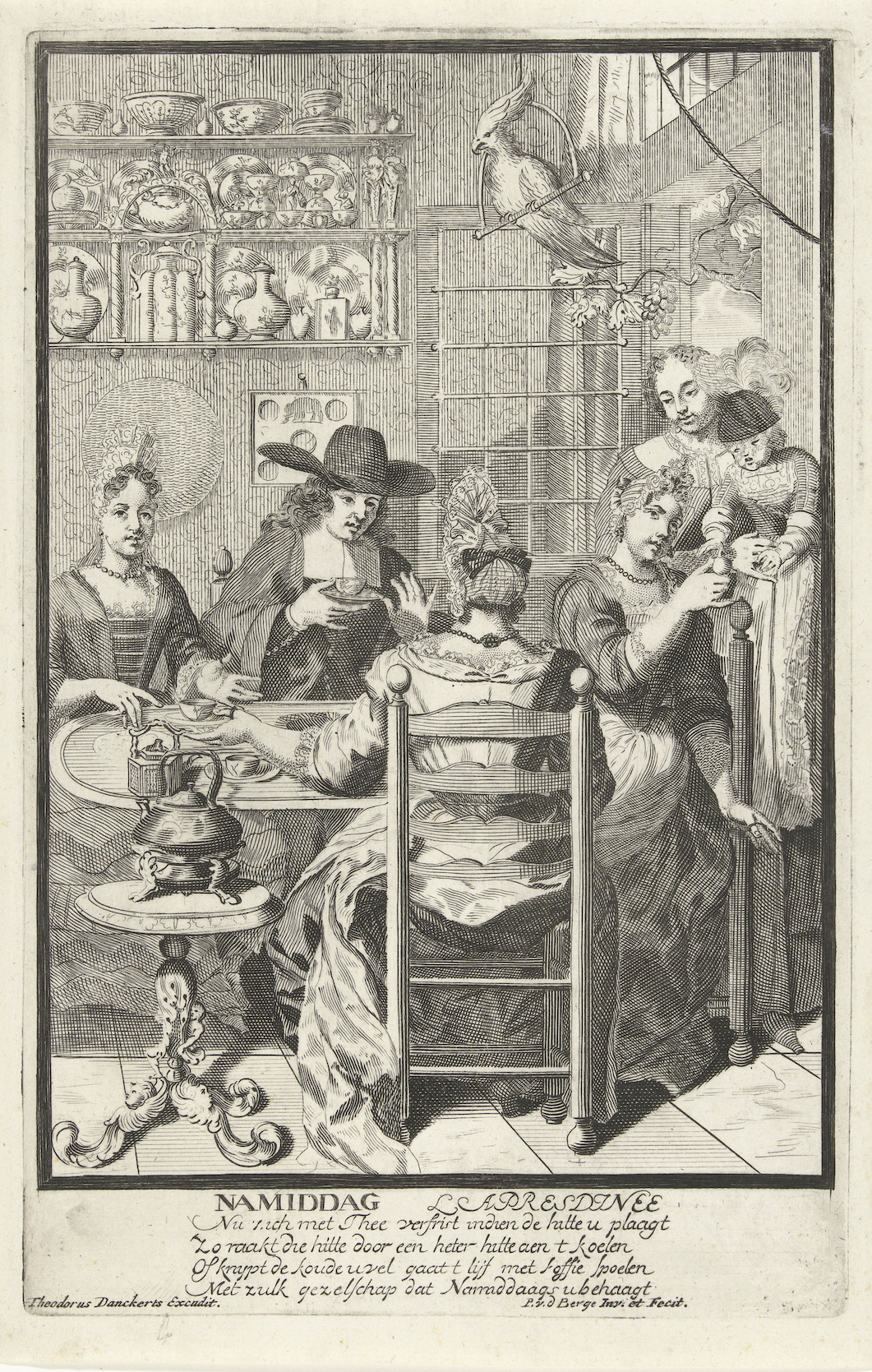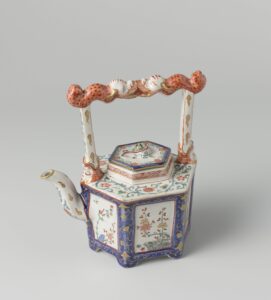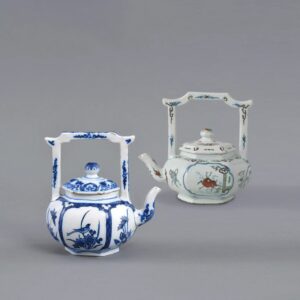
Teapots
A print by Pieter van den Berge from 1708 gives a perfect impression of the increasing popularity of drinking tea in the Dutch Republic in the course of the 17th century. With the practice the need for appropriate accoutrements also grew. As the print shows, tea was consumed slightly differently than today. Hot water was poured from a water kettle into a small teapot. This pot contained a mélange of teas, often a personal blend made by the mistress of the house. The strong tea was poured into small porcelain or earthenware cups and consumed with copious amounts of sugar.
Chinese stoneware teapots, that were particularly suited for brewing tea, were imported by the VOC. In the Netherlands these pots were not only used to drink tea, but also placed in the interior as a decorative feature alongside porcelain. The Leiden merchant Allard de la Court mentions eleven “red earthen” teapots in his inventory drawn up in 1749. Four with mounts were on display over the fireplaces in various rooms, while the others were kept in cabinets, the contents of which were designated “porcelain for daily use.” A small pot or tea cannister by factory Het Moriaanshooft shows a man and a woman taking tea. Depictions of stoneware teapots are included on the shelving behind the couple and in the decorative strapwork that frames the cartouche. (afb. Boijmans van Beuningen, inv. nr. 4085) Similarly a covered pot from the same factory decorated with a company taking tea, shows a wall mounted shelf with a stoneware teacup and a teapot with a noteworthy overhead handle in the shape of a yoke. See: S. Lambooy (red.), Koninklijk Blauw. Het mooiste Delfts aardewerk van Willem en Mary., 2020, p. 51 (Kulturstiftung Sachsen-Anhalt, Kunstmuseum Moritzburg Halle (Saale) MOKHWFA00080))

Perhaps not entirely coincidental, Het Moriaanshooft produced a number of earthenware versions of this type of teapot. The shape with the overhead handle is directly taken from the Chinese stoneware examples, while the blue-and-white decorations are based on Chinese porcelain. Teapots with the overhead handles shaped like a yoke are very rare in Delftware. They were technically very difficult to make and seem to have been somewhat of a specialty of Het Moriaanshooft. A blue-and-white example is the only known teapot marked IW for Jacob Wemmersz. Hoppesteyn. The hexagonal shape is emphasized by blue ribs that create cartouches on each of the panels that are decorated with birds and flowers. This teapot recently entered the collection of the Rijksmuseum, thanks to a generous donation. (BK-2021-17) A second example in Museum Boijmans van Beuningen is unmarked, but very similar in shape. (inv. nr. 4544) Jacob Hoppesteyn became the sole owner of Het Moriaanshooft in 1664, after having obtained a partial ownership in 1659. Because of his death in 1671 it is possible that the teapot was not made during his leadership, but that of his widow Jannetge van Straten. Van Straten, who came from a family of potters, took over the leadership of the factory. This was not unusual. Widows were allowed to continue their husbands’ companies, without making the masterpiece necessary for admission into the guild. Even though Van Straten remarried a year after Hoppesteyns death, she continued to mark objects with her first husband’s initials IW.
When Jannetge died in 1686, their son Rochus took over the leadership of the factory. He continued the production of the teapots with overhead handles but altered their shape. The slightly more compressed body of the teapots resembles stoneware examples more closely, while the rounder shape of the earlier ones also shows similarities to porcelain winejugs with overhead handles. (Collection Rijksmuseum, NG- 1977-174-W).
Het Moriaanshooft is often associated with the re-introduction of polychrome decorations onto earthenware using the petit feu technique. The teapots created under Rochus Hoppesteyn all have polychrome decorations. Two teapots with overhead handles, now at Wallington Hall, Northumberland, are decorated with gnarly floral patterns in a subdued pallete of blue, green, red and yellow. A third example in the collection of the Rijksmuseum is decorated with cartouches showing a jumping stag in the same colors. A finalexample in the same shape but without the overhead handle at the Metropolitan Museum of Art, is similarly decorated with a cartouche. (inv. nr. 50.211.38a, b).
Even though no IW marked polychrome teapots are known, this palette was executed when Van Straten ran the factory. A number of dishes with mythological scenes in blue-and-white and polychrome borders decorated with the coat of arms of the dukes of Brunswick- Lϋnenburg can be dated around 1682, well after Jacob’s death. Moreover, a guild ordinance of 1696 places the introduction of the petit feu technique in the early 1680s when Van Straten ran the factory.

We can tentatively paint a picture in which women played a particularly important role in the introduction and success of polychrome petit feu decorations on Delftware. Thirty years after Van Straten, another woman, Johanna van der Heul, widow of Pieter Adrianus Kocx of De Grieksche A, famously had contracts drawn up between her and four ‘gold painters’ including Ary van Rijsselbergh, demanding that the painters work exclusively for her. It is unlikely that either Van Straten or Van der Heul were directly involved in the technical innovations that the new decorations required. In fact, the petit feu technique offered unique opportunities for painters to work outside the factory, using smaller kilns that were fired at a lower temperature. A guild ordinance from 1696 allowed ‘goudschilders’ to work from home using the smaller kilns. This is also apparent in the contract between Johanna van der Heul and her four ‘goudschilders’. Similarly Van Straten may have worked with the Rotterdam painter Jeremias Godtling. But their involvement shows how keenly aware these two women were of the commercial potential of the technique and the lengths they went through to secure it for their factories.
The smaller kilns needed for the petit feu technique are also associated with tea wares specifically. It is therefore particularly interesting that the form of the Chinese stoneware teapots was used once more in Delft on a gilded and polychrome teapot that can be dated around 1730. It is unmarked but reminds us very much of the work of the goudschilders of De Grieksche A.
Text by:
Femke Diercks, MA. Head of Decorative Arts of Rijksmuseum, Amsterdam



